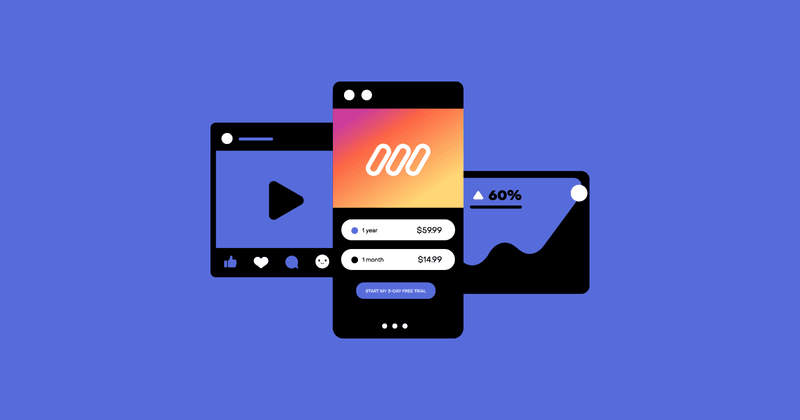How Mojo achieved a remarkable 60% increase in ARPU in just five months
Get an insider’s view of the experiments that ramped up Mojo’s ARPU to new heights.


Michal Parizek
At Mojo, we’ve recently witnessed something truly remarkable — a staggering 60% surge in ARPU7D (Realized LTV per New User in 7 Days) in just a mere five months.
What’s even more astounding is that we accomplished this feat with minimal engineering resources, as we’ll delve into later in this post.
Now, let’s dive into the story and key insights that could potentially serve as a guide to achieving similar success.

The genesis of our journey
As the year 2022 drew to a close, Mojo made a strategic shift, redirecting its focus from Instagram Stories to Reels, and a broader emphasis on video editing. This strategic pivot breathed new life into our growth.
However, our leadership sought sustainable growth, avoiding the path of pouring hundreds of thousands of Euros into advertisements. This is where Bernard Bontemps, Head of Growth at Mojo, played a pivotal role. He proposed (next to other pillars) a Monetization strategy, suspecting substantial opportunities for improvement.
Presenting a compelling business case, Bernard successfully pitched his ideas to the leadership board. Consequently, he initiated the first round of experiments and began the hunt for a dedicated Product Growth specialist.
I joined the Mojo team in May 2023 and took the reins of Mojo’s monetization efforts from Bernard. Over the next few months, we launched dozens of paywall and pricing experiments, with a success rate of over 70%.
I am fully aware of the fact that such a success rate is not usual. It’s an outcome of thorough prior research, ideation, and prioritization. Spend a lot of time on that, it will pay off!
Out of these dozens of trials, three changes emerged as the most influential.
1. Yearly plan as the default and seemingly only choice
Traditionally, our paywall presented both subscription options (yearly and monthly) upfront. However, we conducted an experiment by showcasing only the yearly option, with the monthly alternative accessible through a “View All Plans” link.
This seemingly minor adjustment resulted in a notable 15-20 percentage point increase in the proportion of yearly subscriptions.
You should anticipate a probable uptick in the cancellation rate proxy metric – for two reasons:
- Yearly plans typically have higher subscription cancellation rates.
- The screen is now simpler from a cognitive point of view since users don’t see two plan options, and they might make decisions more spontaneously (and later regret it).
Fortunately, at Mojo, this yielded only a minor increment.

2. Finding the sweet spot prices
As expected, changing actual prices had a significant impact. In several countries (e.g. USA 🇺🇸, Germany 🇩🇪), we heightened yearly prices for new users by 50%, with minimal adverse effects on the free-to-paid conversion rate.
Conversely, in certain countries (e.g. Brazil 🇧🇷), we introduced lower prices which, as it turned out, proved more advantageous both in the short and long run.
In price testing, we set a new testing price individually – never blindly trust Apple to define prices on our behalf mirroring USD or EUR. Usually, we test one or two price alternatives. If we have insights that we might be too expensive in some markets (e.g. low new-to-trial/paid conversion, region purchase power, competition comparison), we make sure a lower price point is among the variants.
The criteria guiding pricing experiments encompass:
- Impact on new revenue (during the 7-day conversion period).
- Impact on 13-month revenue prediction, which involves things like the share of yearly/monthly plans and a subscription cancellation rate (with a 7-day cancellation rate as a proxy).
This approach allowed us to keep our eyes on both short-term and long-term goals.
3. Anchoring users to monthly price for annual billing
Presenting the annual price as “$X/month, billed annually as XX/month” proved exceedingly effective, particularly in lower-income regions:
- A 45% increase in new revenue per a paywall impression in Brazil 🇧🇷
- A 26% increase in Mexico 🇲🇽
- A 8% increase in the USA 🇺🇸
This surge was attributed to heightened paywall-to-trial conversion rates and a greater share of yearly plans.
You should also be aware that Apple has guidelines and limitations on price presentation, so you always have to find a balance between what’s allowed and what you want to experiment with.

Monetization: A collaborative effort
As mentioned earlier, these achievements were unlocked with minimal engineering resources, allowing us to act swiftly. The key to our success lies in having the right tools in place, which form our tech stack in Monetization:
Superwall – A paywall infrastructure for mobile apps that enables rapid deployment of new paywalls with minimal engineering involvement. It also offers a convenient paywall editor for small copy and design changes.
Amplitude – A well-known product analytics. It simplifies data retrieval and empowers product and growth practitioners to surface insights I need very quickly.
RevenueCat – Although it doesn’t empower you with vast filtering and analytical capabilities, RevenueCat’s simplicity and accuracy proved to be its strengths. It’s invaluable for monitoring cohort-based ARPU with different conversion/customer lifetime windows.
Nevertheless, monetization isn’t a solitary endeavor. It sits at the intersection of Product and Marketing, and the synergy between these two areas facilitated our monetization wins.
The Essentials: A great product and effective marketing
Mojo boasts an impressive long-term rating of 4.9/5, with much of our initial growth being organic, driven by word-of-mouth.
Behind this success are our outstanding engineers, designers, and product managers who tirelessly work to create the best video editing app. A great product is essential for long-term monetization success.
Moreover, the allocation of the marketing budget plays a pivotal role in monetization effectiveness. The quality of installs closely correlates with monetization, making the relationship with growth marketing crucial.
Proper attribution and budget allocation across platforms, channels, and countries are challenging but essential tasks. A well-optimized marketing mix significantly impacts monetization effectiveness and can lead to a compounding effect when executed correctly.
More effective monetization results in higher ROI and potentially higher spending. It leads then to New revenue boosts and a higher sample size for your experiments.
What lies ahead?
As I write this post, we’re currently experimenting with extending the free trial period for yearly plans from 3 days to 7 days. The initial results from our key markets look very promising!
If we decide to roll out the 7-day trial, it will necessitate changes in how we measure our monetization effectiveness, shifting from ARPU7D to ARPU14D in RevenueCat. And we’ll also need to reassess how we measure the ROI of marketing spent.
Furthermore, in Q4, we plan to experiment with discount campaigns, the ratio of gated and ungated features and content, and revisit price experiments. As Shreya Oswal and Keya Patel from Headspace mentioned in a SubClub episode, retesting pricing every 6 months, at a minimum, is essential.
PS: Big thanks to Thomas Petit for priceless feedback, which helped me shape this blog post tremendously.
In-App Subscriptions Made Easy
See why thousands of the world's tops apps use RevenueCat to power in-app purchases, analyze subscription data, and grow revenue on iOS, Android, and the web.



